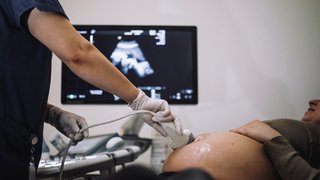Boy or girl? The difficulties of early gender prediction
April 9, 2025

There’s no shortage of old wives’ tales for how to predict a baby’s gender.
- Tie a ring to a piece of string and hang it over your belly. If it swings in a circle, it’s a boy; if it swings back and forth, it’s a girl.
- Craving sweets? It’s a girl. Can’t put down the salty and sour foods? It’s a boy.
- Little girls will steal your beauty. If you develop acne or other skin problems, you’re having a girl.
While gender prediction tests may be fun, they certainly aren’t scientifically proven. Even medical tests that predict gender aren’t always right – and this is especially true in early pregnancy, as McKinney, Texas, resident Tiffany Donnell found out.
I’ll let Tiffany tell her story, and then we’ll talk about how babies’ genitalia develop, how we may be able to predict a baby’s gender and when, and why you shouldn’t expect to learn your baby’s gender early. But first, here’s Tiffany’s story.
It’s a girl!
My husband, Dru, and I are planners. So when we found out we were expecting our first child on Jan. 2, 2017, we knew we wanted to find out the gender. We wanted to pick colors, decorate the nursery, and buy clothes before our little one arrived.
I turned 35 this year, and my Ob/Gyn referred me to a maternal-fetal medicine (MFM) specialist for some extra tests because of my age. They told me if I waited to have the tests done at 12 weeks, they may be able to determine the gender through ultrasound.
We were thrilled at that time to be told we were having a girl.
However, we didn’t rush out to buy pink clothes and paint for the nursery. The MFM said while ultrasound was 90 percent accurate in predicting gender at 12 weeks, and she and the sonographer were fairly confident in their prediction, we should wait until our 20-week anatomy ultrasound to be sure.
We told our parents we were having a girl, but we warned them against buying anything until the next ultrasound. And while we refrained from buying anything, we were definitely thinking pink. My Pinterest board was very girly! We also picked out about 20 girls names – and five boys names just in case.
It’s a boy!
We went to the 20-week ultrasound pretty confident we’d soon be buying pink clothes. The sonographer asked if we wanted to guess what we were having. My husband said, “I’m pretty sure nothing has changed, so it’s a girl.”
The sonographer responded, “Well, something has changed. You’re having a boy!”
We were shocked, but also excited. The sonographer walked us photo-by-photo through the anatomy and we got to see our little boy move around. It was such a special moment for the two of us.
We had a gender reveal party soon after, and our parents thought we had played a joke on them. We reminded them that we said we were 90 percent sure, not 100 percent sure!
It’s fun to find out whether you might be having a boy or girl early in your pregnancy. But take it from us — it’s just a prediction, and things might change!

How babies’ genitalia develop and ‘nub theory’
Tiffany’s not the only woman to whom this has happened. I actually had a similar experience. I was told I likely was having a boy during an ultrasound to screen for Down syndrome at about 12 weeks. However, we could clearly see during the 20-week ultrasound that my daughter was most certainly not a boy!
Your baby’s gender is determined at the moment of conception – when the sperm contributed a Y chromosome, which creates a boy, or an X chromosome, which creates a girl. Boys’ and girls’ genitals develop along the same path with no outward sign of gender until about nine weeks. It’s at that point that the genital tubercle begins to develop into a penis or clitoris. However, it’s not until 14 or 15 weeks that you can clearly begin to see the differentiated genitalia.
So how can we predict gender before then? Blood tests to screen for certain conditions can tell us gender after nine weeks. At 12 weeks, we may be able to use ultrasound to determine gender based on the angle of the genital tubercle. This is sometimes called “nub theory.” Using this method, the sonographer looks at whether the tubercle is pointing up toward the baby’s head, which indicates a boy, or whether it remains flat or points down, indicating a girl.
A 2016 study looked at the accuracy of such tests. The researchers found that out of 672 cases, sex determination was possible 90 percent of the time, and the prediction was correct 87 percent of the time. While those percentages may seem pretty high, it’s not as easy as it sounds.
Difficulties determining gender during the first trimester
There are a number of variables that can affect whether we can determine gender as early as 12 weeks. First, your baby needs to be in a position for us to get a good photo. That includes not having their legs closed! Keep in mind, the sonographer may not have extra time between appointments to wait for the baby to move into a better position to make a prediction.
A mother’s weight also affects our ability to predict gender. The more body tissue the ultrasound waves must travel through, the fuzzier the images may be. The 2016 study I mentioned found that a body mass index below 23.8 was the best cutoff value for gender prediction at 11 to 13 weeks. The odds of an accurate prediction fall for women above that number.
There’s also a chance that our prediction simply will be wrong. We tend to overpredict boys more often than girls. This can happen, for example, if the baby is developing slowly and the tubercle hasn’t begun to point up or the umbilical cord is mistaken for a penis.
While gender prediction is much more accurate during the 20-week ultrasound, there’s still a chance it can be wrong. I recently had a patient who was expecting a boy. She and her husband had a name picked out and had painted the nursery for a boy when they found out shortly before giving birth that they actually were having a daughter. They were shocked but took the news in stride.
I want to stress that the main goal of blood tests and ultrasounds during the first trimester or early second trimester is not to determine gender. Ultrasounds are used to screen for certain conditions and check whether there is something noticeably wrong with your baby. While we understand you may be eager to learn the gender, try not to be upset if your sonographer can’t predict it.











